|

Noting down a game GIPF is more complex than
e.g. taking notes in chess. The main reason is the hexagonal shape
of the board, which makes it possible to move pieces in six directions.
On top of that, there are many cases in which (1) more than one
piece changes position in a single move, (2) pieces of both colors
are to be removed from the board and (3) players must decide whether
or not a GIPF-piece will be taken from the board.
Below you'll find two methods of taking notes: a short way
and a complete way. The short way is meant to make quick
notes, e.g. during a tournament; the complete way will contain information
about the moving and capturing of every single piece, including
the pieces left in reserve. This is to make it easier to keep track
with the notes when re-playing a game.
Preparation
The board must be placed between the players
in such a way that the dot marked with "E1" points at the player
with the white pieces. The vertical lines on the board (i.e. the
lines crossing the board from the one player to the other) are used
to determine the coordinates. From the white player's point of view,
they are characterized from the left to the right by the letters
a, b, c, d, e, f, g, h and i.
No difference between spots (the intersections) and dots
(surrounding the board) is made to determine the coordinates. Both
are to be counted from White towards Black. E.g. the central e-line
has 9 coordinates and the lines at the left- and right-hand side
of the board have 5 coordinates. The central spot is e5.
Note sheet
Example
The sheet shows two columns. The numbers in between these columns
serve to count the moves. White starts and as a result of this,
the "white moves" are to be noted down in the first column, the
"black moves" in the second column.
When you don't use a printed note sheet, we advise you to write
each move on a new line or to use a slash (/) to separate the moves.
A move
There's no difference between noting down a
move the short way and the complete way.
1. You push a piece onto an empty spot. In this case you only note
down the coordinate of the spot you occupy (= the end of the move).
Since you didn't move any other piece, it is of no importance from
which dot the piece was coming and therefore the coordinate of the
dot must not be mentioned.
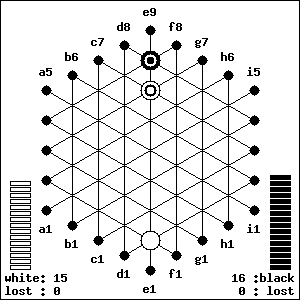 Diagram
1 Diagram
1
White pushed a piece onto spot e2. It makes no difference whether
the pieces came from on d1, e1 or f1.
Short:
e2
Complete: e2
2. You push a piece onto an occupied spot. Now
you must first note down the coordinate of the dot on which you
place your piece before you push it into play (= the beginning of
the move), and next the coordinate of the spot occupied by the furthest
piece in the row after having made the move. (= the end of
the move).
(When you take short notes, it is even easier to just note down
the move of the piece you introduce: note down on which dot you
put the piece and next the spot you push it onto. You may prefer
this manner when noting down your first games.)
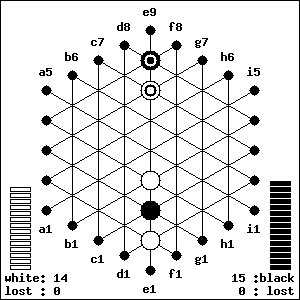 Diagram
2 Diagram
2
White pushed a new piece on e2 and, by doing so, pushed a black
and a white piece one spot further. The GIPF- pieces didn't move,
thus must not be taken into the notation.
Short: e1-e4 (or e1-e2)
Complete: e1-e4
Remark: note
that so far the short and complete notes are about the same. The
coordinates for short notes are just a bit more easy to see than
for complete notes. In fact, you can use both systems when taking
short notes, but only the second system when taking complete notes.
"e1-e2" may be quicker, "e1-e4" is unquestionable more clear!
Tournament rules
When playing the tournament version, players
may decide for themselves how many GIPF-pieces they shall bring
into play, so this also must be noted down. It's easy: each time
you bring a GIPF-piece into play, you first write a "G" and next
the coordinates of the move. As soon as you start playing with single
pieces, you just drop the "G".
Example of notes of the beginning of a game: White starts with three
GIPF-pieces, Black with five.
| |
White |
Black |
| 1. |
Ge2 |
Gd1-f2 |
| 2. |
Gd2 |
Ge8 |
| 3. |
Gd1-g2 |
Gg1-e3 |
| 4. |
c1-f3 |
Ge1-e4 |
| 5. |
f7 |
Gf1-f4 |
| 6. |
c1-g3 |
h2 |
| 7. |
etc. |
|
Capturing basic pieces
The taking of pieces must be marked with an
"x". When you have to take pieces from the board because of
a move made by your opponent, you must remove them before
you make your move. This means that you must note down the "x" before
the notation of your move. When you create a capturing situation
yourself, then you remove the pieces after having made a move and,
thus, you note down the "x" after your move. The data of
the capturing and the move must be separated by a semicolon.
For complete notes, you note down the coordinates of the removed
pieces after the "x" and mark the opponent's pieces with a star
(*).
 Diagram
3 Diagram
3
Black just played and created a white row, so White must remove
the 4 pieces on the b1-i4 line before making a move.
Short: x;
next white move
Complete: c2,d3,e4,f4x; next white move
 Diagram
4 Diagram
4
White played g1-c3 and captures…
Short: g1-c3;x (or g1-f2;x)
Complete: g1-c3;xc2,d3,e4,f4,g4*
Capturing GIPF-pieces
A GIPF-piece is always assumed to be left on
the board, unless it is shown in the notation. If you decide to
remove one or more GIPF-pieces (your owns or your opponent's) this
must be shown in the notes. When taking short notes, you may just
note down an x followed by the coordinates of the removed GIPF-pieces.
When taking complete notes, you start the notation of each removed
GIPF-piece with a "G" (and mark your opponent's also with a star).
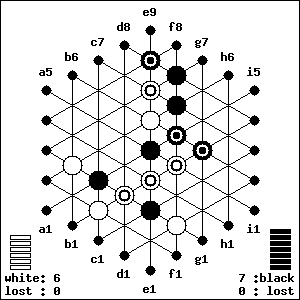 Diagram
5 Diagram
5
White played a3-f2 and caused a capturing situation in which GIPF-pieces
are involved. Let's assume that White will remove the Black GIPF-piece
on g4 and his own white GIPF-piece on f4, and leave the GIPF-pieces
on d3 and e4 on the board.
Short: a3-f2;xg4,f4 (or
a3-b3;xg4,f4)
Complete: a3-f2;xc1,Gf4,Gg4*
Note:
for more clearness you can also note down the "G" when taking short
notes: a3-f2;xGf4,Gg4
Special cases
1. When taking short notes and you have to choose
between two intersecting rows, you must also note down the "dots"
of the line you take pieces from. Put them between brackets.
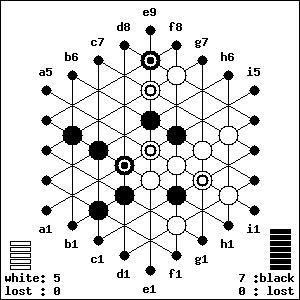 Diagram
6 Diagram
6
White played f1-f5 and created 2 rows of 4. Let's assume that he
will chose the row with the black pieces on c2 and d3.
Short: f1-f5;x(b1-i4)
(or f1-f2;x(b1-i4))
Remark: if the player would take the other row and decide
to remove a GIPF-piece, then the coordinate of the GIPF-piece would
be sufficient to know which of the two lines is taken, in which
case there's no need to specify a line.
2. If you capture two rows, then both must be shown in the notes,
separated by a semicolon.
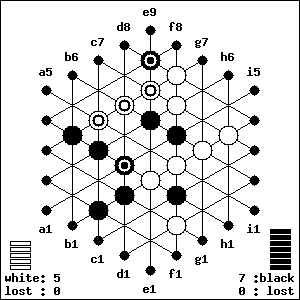 Diagram
7 Diagram
7
White played f1-f7 and created 2 rows of 4, which do not intersect
each other.
Short:
f1-f7;x;x (or f1-f2;x;x), assuming that the GIPF-pieces are left
on the board.
Complete:
f1-f7;xb4*,f7;xc2*,d3*,e4,f4,g4,h4
The reserve
When taking complete notes, you may want to
add the number of pieces left in reserve at the end of each move
between brackets. This is very useful when re-playing a game of
GIPF.
Text
When writing about a game of GIPF, then use
a slash (/) to separate the white from the black moves. Example:
1.Ge2/Gd1-f2 2.Gd2/Ge8 3.Gd1-g2/Gg1-e3 4.c1-f3/Ge1-e4 5.f7/Gf1-f4
6.c1-g3/g1-g4 etc.
It is also possible to use the number of pieces left in the reserve
(between brackets) to separate the moves. Example: 1.Ge2 (16) Gd1-f2
(16) 2.Gd2 (14) Ge8 (14) 3.Gd1-g2 (12) Gg1-e3 (12) 4.c1-f3 (11)
Ge1-e4 (10) 5.f7(10) Gf1-f4 (8) 6.c1-g3 (9) g1-g4 (7) etc.
The end
When a player has no more GIPF-pieces on the
board or no more basic pieces in his reserve, you note down a capital
"X" in his column, at the end of the notations. Meaning: "game over"
or "resignation".
When using the text format to take notes, then end with 1-0 or 0-1,
depending on a win for white or for black.
This is about what you need to know about taking notes. It won't
be easy to note down your first game, but maybe it will help if
you keep that one cliché in mind: you only learn by doing.
Examples
The same game 3 times:
Short notes
Complete notes
Text format
Archives
You'll find plenty of games to take a look at
in the GIPF-archives.

|